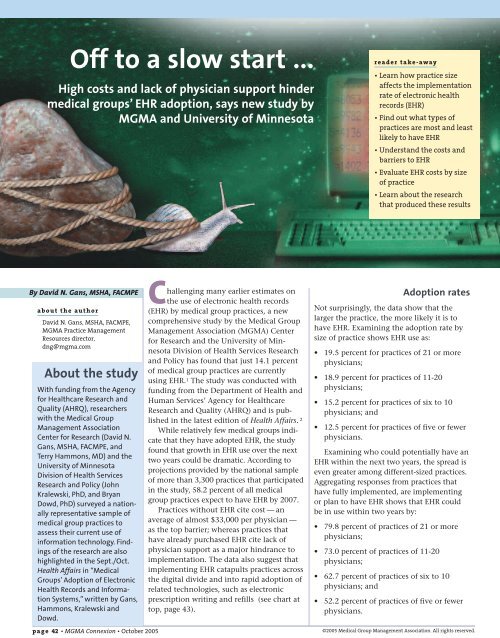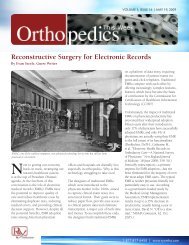Off to a slow start ...
Off to a slow start ...
Off to a slow start ...
- No tags were found...
Create successful ePaper yourself
Turn your PDF publications into a flip-book with our unique Google optimized e-Paper software.
Unused capabilitiesThe report provides significant insight in<strong>to</strong>which EHR capabilities practices actuallyuse, as not every EHR has all functions andnot every medical group fully uses the capabilitiesof its EHR system. More than 97percent of the respondents with an EHRreported that their systems had functions forpatient medications/prescriptions, patientdemographics and visit/encounter notes,but less than 65 percent reported that theEHR provided drug formulary informationor clinical guidelines and pro<strong>to</strong>cols.Equally important was that only 83.1percent of respondents said their EHR wasintegrated with the practice billing system.Integration with the practice billing systemfacilitates cost savings by eliminating keyentryof billing information, improvescharge capture and enhances documentationof billed services in the medical record.President Bush has described the use ofEHR and related technologies as a keycomponent in the national health carestrategy of lowering costs, improving qualityand reducing medical errors. However,given the current state of adoption — andeven if all the practices with plans <strong>to</strong> implementEHR during the next two years do so— at least 40 percent of medical grouppractices will still be using paper records ata critical time in the execution of thisnational strategy.The economic case for EHR is still beingevaluated. Unless the cost barrier <strong>to</strong> adoptioncan be breached, it may be impossible<strong>to</strong> reach the national goal of providing allAmericans access <strong>to</strong> reasonably priced,quality health services.n o t e s1. Hammons T, Kralewski J, Gans D, Dowd B. The adoptionof electronic health records and associated informationsystems by medical group practices. Finalreport, AHRQ task order No. 5. 15 July, 2005.2. Gans D, Kralewski J, Hammons T, Dowd B. Medicalgroups’ adoption of electronic health records andinformation systems. Health Aff 2005; 24: 1323-1333.@ w w w. m g m a . c o m• In the MGMA KnowledgeCenter in the member area,choose Article Archive andsearch under “electronicmedical records”; chooseTools and try the “Electronichealth record practicereadiness assessment”• In the S<strong>to</strong>re, enter 6266 inthe Search box for the bookElectronic Health Records:Transforming Your MedicalPracticee - m a i l u sAre you planning <strong>to</strong> implementEHR? What barriers areholding you back? Tell us atconnexion@mgma.comPolicy implications of EHR researchThe implications for Congress and theadministration of the recent research onuse of electronic health records (EHR)by medical group practices are significant.As federal health policymakersdesign proposals <strong>to</strong> create a nationalhealth information infrastructure, theywill have <strong>to</strong> take in<strong>to</strong> account the stilllowrates of adoption in group practices(see “<strong>Off</strong> <strong>to</strong> a <strong>slow</strong> <strong>start</strong> ... ” page 42).Equally important <strong>to</strong> policymakers istheir desire <strong>to</strong> see health informationtechnology used <strong>to</strong> improve clinicalquality and reporting for clinicians whoprovide services <strong>to</strong> beneficiaries of publiclyfunded health programs. Thepromised improvement cannot takeplace with the current low rates of adoption.The Medical Group ManagementAssociation (MGMA), which conductedthe research with the University of Minnesota,has widely shared this surveywith lawmakers, administration officialsand medical specialty societies.Besides concerns over the lack ofreturn on investment and initial costbarriers <strong>to</strong> purchasing health informationtechnology, MGMA also has deliveredthese messages <strong>to</strong> policymakersthrough this survey:• Smaller practices <strong>slow</strong>er <strong>to</strong> adopt —As expected, larger practices haveimplemented EHR at a higher ratethan smaller practices. In addition,medical specialty practices tended <strong>to</strong>implement EHR at a higher ratethan primary care offices.• Complicated implementation/reduced productivity — Surveyrespondents indicated that medicalpractices found it significantly moredifficult <strong>to</strong> implement EHR thanthey had anticipated. In addition <strong>to</strong>the high initial purchase cost,respondents experienced a significantreduction in productivity, atleast through the implementationand acclimation period. Medicalpractices reported decreases in physicianproductivity of up <strong>to</strong> 15 percent,usually lasting a year or more.Despite a widespread belief that EHRwill increase productivity and reducecosts for practices, the evidence fromthe research demonstrates that productivityis reduced substantially duringthe implementation of and transition<strong>to</strong> EHR. Medical practices report thatthe high initial purchase amount andreduced productivity, combined with alack of reliable financial cost/benefitstudies of EHR implementation, makesit difficult <strong>to</strong> establish a business casefor EHR adoption. The study reportedthat medical groups that have implementedEHR assessed the clinical benefitssuch as improved access <strong>to</strong> medicalrecord information, improved workflow and improved patient communicationsas far more important thaneconomic benefits.MGMA Connexion • Oc<strong>to</strong>ber 2005 • p a g e 45




